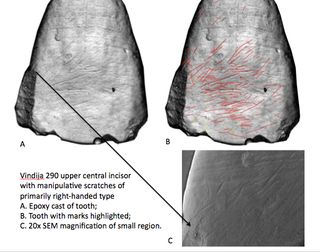Ancient Humans Were Mostly Right-Handed, Too

Humanity's right-hand dominance might be more than 500,000 years old, new research indicates. The trait of right-handedness is commonly believed to be a sign of the development of another uniquely human trait -- language.
"We are right-handed because the left side of the brain controls the right side of the body, and the left side of brain is where language is processed," study researcher David Frayer, of the University of Kansas, told LiveScience. "This is important because it tells us that they were brain lateralized just like we are, and they probably had a language capacity."
Previous studies of ancient humans have shown evidence of handedness in tools, cave art, and bones, but these types of handedness data have been controversial.
Toothy testing
Scientists found evidence of ancient humans' handedness in an odd place: front teeth. Scratch marks can be used to determine if ancient Homo species, living more than 500,000 years ago, used their right or left hands to process animal hides. (During processing, they would stretch the hide by holding one side with one of their hands and the other in their mouth.)
"All you need to have is a single tooth and you can tell, if our assumptions are right, if the individual is right- or left-handed," Frayer told LiveScience. "The fossils are just like humans in that we are mostly right-handed and so were they."
The scientists looked for wear and tear caused by a stone tool accidentally raking across the surface of the front teeth while working a hide with the dominant hand. Right-handed scratches went from the upper-left side of the tooth to the lower-right side, and left-handed scratches show the opposite pattern.
Sign up for the Live Science daily newsletter now
Get the world’s most fascinating discoveries delivered straight to your inbox.
Frayer and his colleagues looked at these markings on the teeth of Neanderthals (from around 100,000 years ago) and their ancestors from 500,000 years ago. In both groups, most of the teeth showed more right handed scratches than left.
Left-brain biased
No animals other than humans show such a bias toward right-handedness. In some primates, such as chimps and gorillas, a small 5 percent shift toward the right can be seen in some studies. This is an example of brain asymmetry, where one side of the brain takes on functions that the other side doesn't.
In addition to our special right-hand dominance, no other animals show the language abilities of humans. No one knows when Homo sapiens developed language, but many researchers believe that brain lateralization was an important part of its origin.
"This finding has important implications for the never-ending debates about the cognitive abilities of Neanderthals," said Dean Falk, a researcher at the School for Advanced Research in Santa Fe, who wasn't involved in the study. She told LiveScience in an email that the "findings convincingly demonstrate that language probably existed by at least half a million years ago."
The study was published April 14 in the journal Laterality.
You can follow LiveScience staff writer Jennifer Welsh on Twitter @microbelover. Follow LiveScience for the latest in science news and discoveries on Twitter @livescienceand on Facebook.
Jennifer Welsh is a Connecticut-based science writer and editor and a regular contributor to Live Science. She also has several years of bench work in cancer research and anti-viral drug discovery under her belt. She has previously written for Science News, VerywellHealth, The Scientist, Discover Magazine, WIRED Science, and Business Insider.
